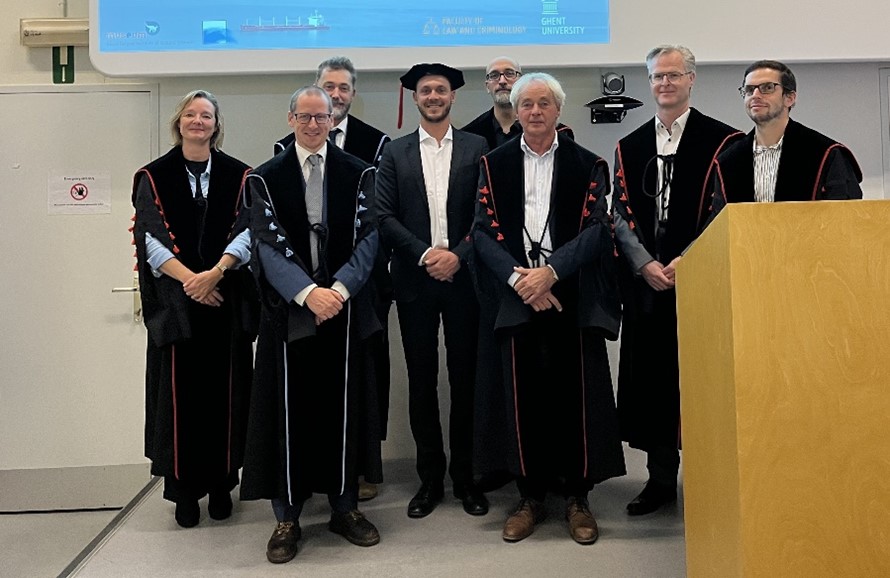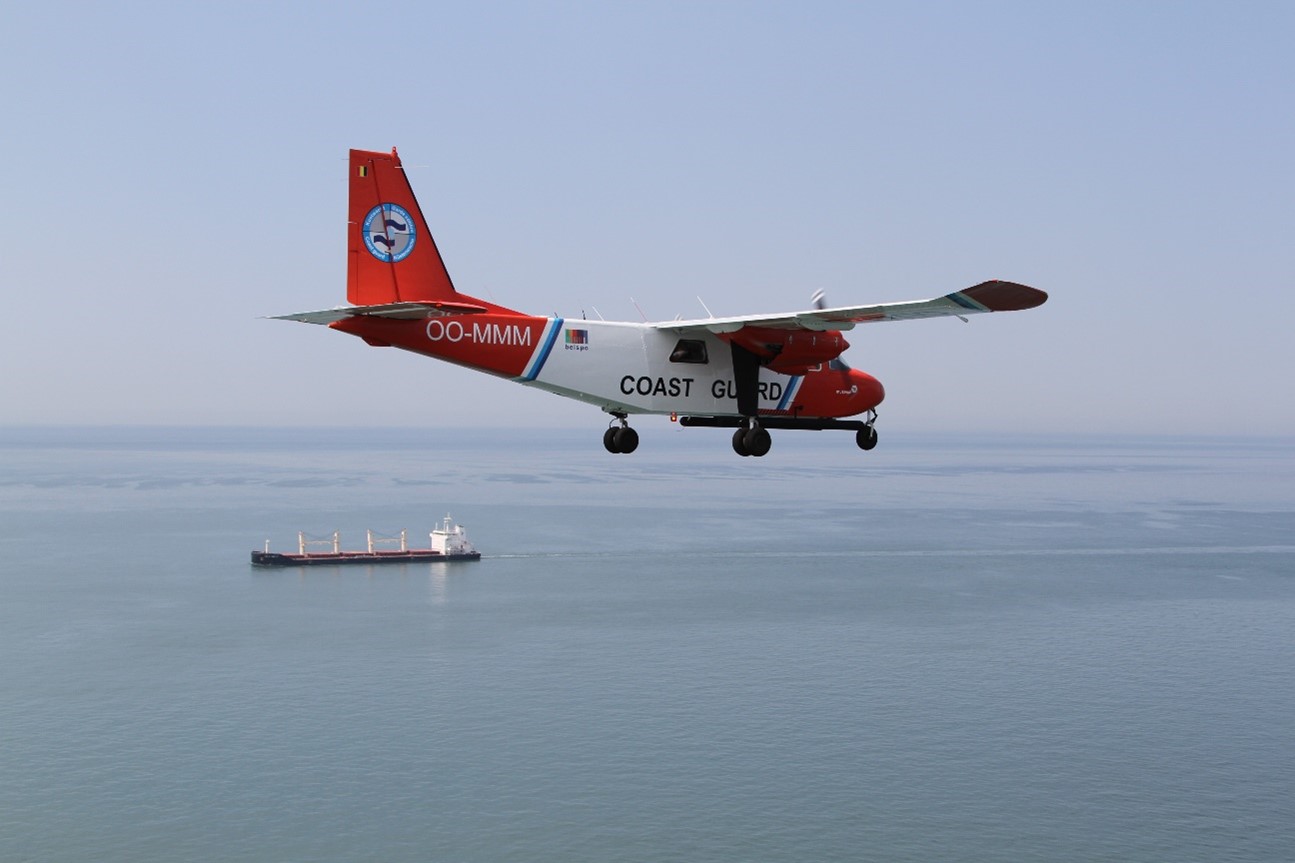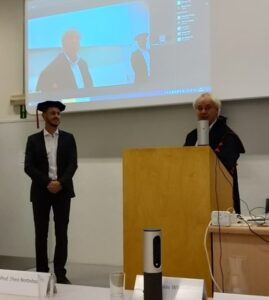Pollutant emissions from ships to air are subject to strict standards worldwide. Ward Van Roy analysed the potential and added value of aerial surveillance for monitoring harmful ship emissions in a doctoral study. To this end, he used data collected with the Belgian aerial surveillance aircraft1. His findings underline the operational benefits of aerial monitoring and provide valuable insights into the effectiveness of international regulations in improving air quality over the North Sea. Moreover, the study revealed regulatory gaps and provides recommendations to resolve them. Ward Van Roy is attached to the Royal Belgian Institute of Natural Sciences (RBINS) and, on 28 September 2023, became the very first doctor of maritime sciences to obtain this degree from the Faculty of Law and Criminology at Ghent University. An extra reason for Ward, Ghent University and RBINS to be proud.

Shipping plays a crucial role in connecting economies and cultures around the world but is also one of the biggest sources of air pollution. Indeed, burning traditional marine fuels creates sulphur compounds, nitrogen compounds and ‘black carbon’, with adverse effects on human health and the environment.
To address this, international efforts have been made to draft regulations2 aimed at reducing ship-to-air emissions. However, without effective enforcement, regulations risk remaining dead letter. This moved Ward Van Roy3 to describe in a PhD the extent to which aerial monitoring can contribute to the development of a strategy for monitoring and enforcing emissions rules for shipping.
Ward’s PhD thesis is titled ‘Application of remote measurements for compliance monitoring and enforcement of SO2 and NOx emissions under Marpol Annex VI‘, and was publicly defended on 28 September 2023 in Ghent as the final step for obtaining the title of doctor of maritime sciences. The research resulted in no less than five articles already published in scientific journals and three submitted for publication.
Method and trends
The first part of the doctoral thesis presents the science-based method for airborne monitoring of ship emissions. The so-called ‘sniffer sensor’ integrated into the Belgian aerial surveillance aircraft plays a central role in this. Thanks to the implementation of several innovations, Ward was also able to significantly improve the method for monitoring sulphur oxides (SOx) in ship emissions. A comprehensive manual, also part of the thesis, ensures the uniformity and quality of measurements and can serve as a guide for setting up corresponding programmes in other countries.
Analysis of the obtained data then shows not only that the international regulations on sulphur dioxide (SO2) and nitrogen oxides (NOx) emissions can be effectively monitored from the air, but also that SO2 emissions regulations are relatively well complied with, both in Belgium and in the larger emission control area encompassing the entire North Sea and Baltic Sea.
Ward Van Roy: “We can conclude that aerial monitoring has actually contributed to the significant reduction in SO2 emissions. For NOx emissions, on the other hand, it appears that the targeted reduction in emissions has not yet been achieved, neither in Belgium nor beyond”.
The analyses used data from Belgian aerial surveillance as well as data from measurement campaigns from other countries, land-based air quality monitoring stations, and satellite imagery.

Unexpected results
However, Ward’s study also uncovered some unexpected trends.
It was thus shown for the first time that ships equipped with after-treatment systems for their emissions to air, known as scrubbers, account for a significantly higher proportion of emission violations. As scrubbers are being installed to reduce emissions of harmful components to the air, this finding runs counter to expectations. Moreover, the use of scrubbers is increasing, already reaching 30 per cent of observed ships by 2022. If this development continues, combined with the current increase in shipping, SO2 emissions from shipping will increase again and the sector will become responsible for a larger share of total SO2 emissions.
Ward also made a remarkable observation with regard to NOx: “My research shows that the average NOx emissions of more recently built ships are significantly higher than those of older ships, which obviously cannot be the intention” he indicates. “Moreover, I found that the regulations, which aim to reduce NOx emissions, are only very slowly taking hold due to the way these international regulations are drafted.” If this does not change, it is expected that the shipping sector will be the largest source of NOx in Flanders by 2025, and will even account for 40 per cent of all NOx emissions by 2030.
Added value and policy recommendations
In his thesis, Ward also reflects extensively on the legal aspects of aerial surveillance and the added value for various stakeholders.
First of all, an important added value could be demonstrated for port inspection services. By identifying potential violators at sea, port inspection services can follow up the ships concerned in a more targeted way when they call at a port, which can lead to sanctioning when necessary. Air monitoring thus appears to positively influence the follow-up and sanctioning of emission violations by ships. A cost-benefit analysis shows that aerial monitoring also pays off financially as a result.
The Belgian findings also benefit international cooperation and are included in efforts to achieve effective and harmonised international monitoring.
Furthermore, based on the experience gained, it also formulates recommendations for policymakers, which can make an effective contribution to reducing air pollution from shipping. These include increasing the direct legal value of aerial measurements (which currently always have to be confirmed by port control), obtaining an internationally accepted protocol to monitor NOx violations at sea and an associated enforcement mechanism, and eliminating certain regulatory gaps. These recommendations are being discussed at the international level in the framework of the Bonn Agreement (cooperation of North Sea states in detecting, reporting and combating pollution in the North Sea) and the International Maritime Organisation (IMO), while in Belgium, solutions are being sought in cooperation with the Directorate-General Shipping (FPS Mobility and Transport), which will find their way into international regulation through federal policymakers.
Additional background
1 The Management Unit of the Mathematical Model of the North Sea (MUMM), Scientific Service of the Royal Belgian Institute of Natural Sciences (RBINS), is responsible for implementing the Belgian aerial surveillance programme over the North Sea. For this purpose, the RBINS owns a Britten Norman Islander type aircraft equipped with scientific sensors for detecting marine pollution, and cooperates with Defence, which provides the pilots. Since 1990, this programme has been producing significant results. The focus is on three groups of core tasks: 1) surveillance of illegal and accidental marine pollution, 2) monitoring of the marine environment and 3) broader maritime surveillance in the context of the Coast Guard (the aircraft therefore bears the inscription ‘Coast Guard’ and is also widely known as ‘Coast Guard aircraft’).
2 Globally applicable emission standards for sulphur and nitrogen are described in Annex VI of the international MARPOL Convention (International Convention for the Prevention of Pollution from Ships). Furthermore, the European Sulphur Directive also prescribes restrictions on sulphur emissions from ships, and sulphur and nitrogen compound emissions are even more strictly regulated in the very busy ‘North Sea and Baltic Sea Emission Control Area’ (of which Belgian waters are also an integral part) than outside it. Black carbon (a measure of airborne soot concentration) from shipping is not yet subject to international restrictions, these emissions are currently being mapped to feed the development of a restrictive framework.

3 Ward Van Roy graduated as a bioengineer from Ghent University in 2008, and later joined the RBINS aerial surveillance team (BMM) as an operator. He is also responsible for managing the scientific instruments and is considered the brain behind the integration of the so-called ‘sniffer sensor’ setup in the Belgian aerial surveillance aircraft. He is thus partly responsible for the team’s international name and fame in the field of airborne ship emission monitoring. Ward has the honour of being the very first person to obtain the title of ‘doctor of maritime sciences’ at Ghent University (Faculty of Law and Criminology).
